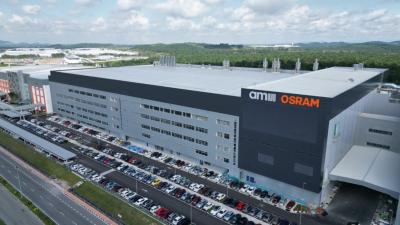A few days ago, Apple decided to cancel its microLED project with ams-Osram, a development that took the display industry by surprise. It certainly surprised ams-Osram, which announced it will have to re-assess its microLED strategy and incur $650-900 million in impairment charges. It is currently unclear whether Apple's decision was to completely abandon microLED technologies, or if it still in the microLED race, perhaps with different technologies and suppliers. It is likely that Apple does not have any immediate plans to introduce microLED displays, though. In this article, we'll try to analyze the reasons which led to Apple's decision and the probable implications for the microLED industry.
Summary:
- Apple cancels its microLED project with ams-Osram
- We estimate that the main reasons are Apple's technology choice and strategy
- MicroLED production will require next-gen technologies to succeed
- MicroLEDs still pose the best route for the future display technology, but companies will need to realign their strategies
Apple worked on microLED R&D since 2014, with a first target of producing microLED smart watch displays to replace the currently-used AMOLED displays. The Company had several partners, and decided to handle some of the process in-house. It seems as if even after almost 10 years of development and intensive R&D (estimates of Apple's total investment in microLED technology so far range between $1-3 billion USD), the technology was not ready for mass production - at least not at a price that Apple can accept.
What went wrong?
First of all, we could estimate that Apple had several goals in its microLED project. First would be to provide a better user experience. MicroLEDs could offer higher brightness and higher efficiency, which can be good for customers, especially in mobile devices.
Apple's current Watch Series 9 Ultra features 1.92" 3000 nits 502x410 LTPO AMOLED displays. That's a very impressive display, with excellent battery life and high brightness. It is not clear how much better a microLED display would be, especially as a first generation. Considering that Apple would only be ready for actual production around 2026, we can assume OLEDs would also progress quite a bit by then, and could reach higher brightness than today.
Apple was probably also keen to improve its supply chain and have better control over its display production. OLED production is limited to a small number of players, and this poses risks for Apple. And, of course, we can assume that Apple wanted to be perceived as an innovator - the first to adopt an exciting new technology.
It seems that these are all good reasons - but they were likely not enough to create a real need to produce a new kind of display, with the massive amounts of investments required. It is likely that a microLED display would have cost at least triple the price of a leading AMOLED, and this was probably not acceptable for Apple.
We believe the main reason for Apple's decision is that it encountered problems due to the fact that it would not adopt next-generation production technologies. Rather, it tried to 'brute-force' its way into microLED mass production using existing technologies. Maybe they should have thought different. Our own analysis on the current status of the microLED industry is that in order to compete with OLEDs, producers must adopt next-gen technologies across the entire process (from LED structure and materials through epiwafer, chip processing to transfer, inspection and more). The reality is that at the current state, microLED production is just too expensive. That's also why we believe mass production will likely not happen before 2030 or so. This also arises from the MicroLED Industry Association's roadmap, released in late 2023.
Implications for the MicroLED industry
As we said, microLED technology offers several major advantages over OLEDs (and LCDs): higher brightness, higher efficiency and longer lifetimes. In addition, the unique properties of microLEDs (no encapsulation, very low aperture ratio) could also be meaningful, for example the possibility of tiling, higher transparency displays and the option of embedding sensors behind the displays.
First of all, we believe that microLEDs still have a very good chance of becoming the next-gen display technology of choice. In fact, it is difficult to see other relevant technologies that could overthrow OLEDs and LCDs, or at least take meaningful market shares. Even without Apple's support, the industry will press forward with microLED innovations. Some display makers have no other choice but to develop microLEDs as it represents the best viable path towards high margin display offerings.
In addition, we think microLED developers should focus on market segments in which these advantages bring real value, maybe even areas where there are no other solutions. One example could be high-end AR devices, where very high brightness is vital (as waveguides lose around 99% of the light). Another example could be automotive with the need for long lasting displays.
Also, we believe that microLED developers should strive to develop technologies that are viable in the long term, suitable for actual mass production. The LCD and OLED display industries are extremely efficient and the cost of producing displays is very low, as everything is done on massive scales. For most display applications, that should be the target.
So, when microLEDs succeed in replacing OLEDs, it will probably be based on very small microLED chips (to reduce costs) and by using extremely efficient processes that will enable low cost production. In addition, the industry should take advantage of the unique advantages of microLEDs - whether for the final display performance, or in the production process (for example the ability to de-couple the production process).
It will be interesting to see where Apple's decision leaves ams-Osram. The company is building a $850 Million 8-inch microLED epiwafer factory in Malaysia. As a first estimate, ams-Osram believes it will have impairment charges of $650-$900 million and it will also likely have to cancel or delay some of its investments in Malaysia (which may actually improve the company's cash flow in the next two years). The Company will need to re-align its strategy now that it has lost its major customer.
But not all should be lost for Osram. The company believes it has the best technology and production process for microLED production, and may press its advantage and approach other display makers, and be open to collaborations with many players. It will be a long road ahead - for Osram and for all other microLED companies, but the potential of microLEDs is very big, to take a meaningful part of the >$100 billion display industry.
We encourage all microLED professionals and companies to join the MicroLED Industry Association and to attend MicroLED-Connect, our flagship industry event in Europe. These steps can prove crucial in fostering industry collaboration, staying updated and fine-tuning go-to-market strategies and decisions, in a pivotal time for microLED technologies.





Comments
Great analysis
This is a very insightful and correct analysis of the market. It is more a testament to the maturity of the eco-system than anything else. The success of microLED comes down strongly to the most innovative technologies working together to make microLED manufacturing efficient and cost-effective.